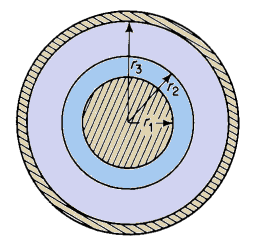| Capacitors, Magnetic Circuits, and Transformers is a free introductory textbook on the physics of capacitors, coils, and transformers. See the editorial for more information.... |

|

Home  Capacitance and Related Effects Capacitance and Related Effects  Graded Insulation Graded Insulation |
|||||||||||||||||






|
|||||||||||||||||
Graded Insulation
Some high-voltage cables use two or more different kinds of insulation (dielectric) in order to achieve a smaller difference in voltage gradient or electric field intensity throughout the insulation. Equation 2-38 shows that in coaxial cable, the electric field intensity varies inversely as the distance from the center of the inner conductor and also inversely as the relative dielectric constant. Therefore, in some types of high-voltage cable, next to the inner conductor a material is used that has a higher relative dielectric constant kr than the material further out. It is then necessary to take the difference in the dielectrics into account in determining the capacitance of the cable. This is done as follows: in Fig. 2-16 the voltage across the dielectric, which has the relative dielectric constant kr12, is expressed by
and the voltage across the outer shell of the dielectric having a dielectric constant kr23 is expressed by
The total voltage from conductor to sheath is expressed by
and the capacitance is expressed by
The electric field intensity at the surface of the inner conductor is
and that inside the sheath is
The ratio of these electric field intensities is
whereas in the case of a homogeneous dielectric this ratio is
It can be seen, therefore, that if the dielectric kr12 is greater than kr23 the voltage gradient in the dielectric is more nearly uniform than it is in a homogeneous medium. Generally in high-voltage cables, in the absence of mechanical imperfections, the dielectric deteriorates more rapidly near the inner conductor because the electric field intensity and the temperature in the dielectric are the greatest at that location.
|
|||||||||||||||||
Home  Capacitance and Related Effects Capacitance and Related Effects  Graded Insulation Graded Insulation |
|||||||||||||||||
Last Update: 2011-01-08










